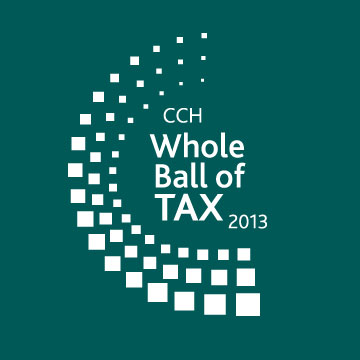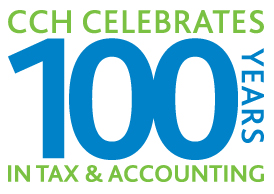| Home | About Us | Order Products | Press Center | Customer Service | Career Opportunities |

CCH can assist you with stories, including interviews with CCH subject experts.
Also, the 2013 Visit the CCH Whole Ball of Tax site often as new releases and other updates will be posted CCH provides special CCH Tax Briefings on key topics at CCHGroup.com/Legislation.
|
Changes in Charitable Contribution Tax Rules Mean Retirees Need to Act FastNew Tax Laws Affect Seniors and Surprise Some Higher Income Taxpayers; But Everyone Needs to Know the Basic Guidelines(RIVERWOODS, ILL., January 2013) – Charity may begin at home, but donors – particularly retirees looking to make charitable contributions from their individual retirement accounts (IRAs) and those in households with earnings above $250,000 – may want to make a quick trip to review the tax rules, according to CCH, a Wolters Kluwer business and a leading global provider of tax, accounting and audit information, software and services (CCHGroup.com). In particular, as a result of the American Taxpayer Relief Act of 2012 (ATRA), retirees are still allowed to make charitable contributions directly from their IRAs as they have been allowed to do for the past several years – including 2012 – retroactively if done in January. But ATRA put further restrictions on the value of tax deductions – including those for charitable donations – for individuals with incomes of $250,000 or more and for married couples filing jointly with incomes above $300,000. Below, CCH reviews the new ATRA rules, as well as recaps important guidelines all taxpayers need to know when reporting charitable contribution deductions. Charitable IRA Contributions for 2012 and 2013Allowing taxpayers to avoid paying taxes on charitable contributions made directly from their IRA accounts had expired after 2011, and as 2012 came to a close, it appeared the rule had no chance of being resurrected. However, ATRA brought it back to life – for both 2012 and 2013. As a result, individuals age 70½ (the age at which required minimum distributions must be taken) or older can give tax-free distributions of up to $100,000 per taxpayer per year to public charities. Because the new law was not signed until early January 2013, it included two special rules to allow seniors to make contributions for 2012 – as long as they are completed in January 2013. They can either:
“The retroactive rules for 2012 add some complexity, but this a very popular tool for both retirees who don’t need all the money they’ve saved in retirement and for charitable organizations,” said Perlman. “The charity gets the money, but the distribution is not counted as income to the taxpayer. It doesn’t get taxed, and it doesn’t increase the taxpayer’s adjusted gross income, which can lead to further tax benefits.” Itemized Deduction Limit (Pease) Could Put a Dent in Value of Charitable Deductions for 2013 and BeyondThe ATRA also brought back the itemized deduction limit that had been repealed under the Bush-era tax cut. Known as the “Pease” limitation, this reduces the total amount of a higher income taxpayer’s allowable itemized deductions. Allowable itemized deductions can include charitable contributions, as well as mortgage interest, state and local income taxes, real estate taxes and medical expenses. Under the Pease limitation, the deduction is reduced by 3 percent of the amount by which the taxpayer’s adjusted gross income (AGI) exceeds the income threshold. The income threshold at which Pease kicks in for 2013 is $250,000 for individuals and $300,000 for married couples filing jointly (adjusted for inflation in subsequent years). However, the amount of itemized deductions under Pease cannot be reduced by more than 80 percent. Also, certain items, such as medical expenses, investment interest and casualty or theft are excluded from the Pease limitation. Doing the MathTrying to understand Pease can quickly become confusing. Following are a few examples of how it can apply:
“Given that about one-third of taxpayers claim itemized deductions, individuals subject to the Pease limitation may be surprised to realize their deductions, including those to charity, have a lower value than in years past,” said Perlman. “Also, the income thresholds at which the Pease limitation applies are considerably lower than the $400,000 and $450,000 income thresholds at which the new highest income tax bracket and the new 20-percent capital gains tax apply,” Perlman added. “As a result, many taxpayers may not be aware that under certain parts of the ATRA they are considered high-income earners while under others they are not.” Pease: A Potential Resurgence of Donor Advised and Charitable TrustsWhile some may be surprised by Pease, taxpayers anticipating its return may have taken actions in 2012 to ensure they could both continue to maximize their deductions while also maximizing their charitable contributions. For example, donor-advised funds allow you to place your money in a charitable fund and take the contribution at that time. You can then advise the fund to make distributions to charities of your choosing over as many years as you choose. Similarly, charitable remainder income trusts allow individuals to set up a trust naming a charitable organization as the beneficiary. Under the trust, you receive the interest income during the remainder of your life, while the charity receives any remaining income you did not withdraw during your lifetime as well as the principal when you die. “These types of vehicles allow you to declare a charitable deduction for the present value of the charitable interest, but delay when the full gift is made,” said Perlman. “However, people interested in charitable trusts or donor-advised funds should speak with their tax advisor before making the significant financial commitment that is usually required to use these vehicles.” Key Tips for Claiming Charitable ContributionsWhile new rules under the ATRA may apply to certain taxpayers, all taxpayers need to follow basic rules to claim charitable contributions as tax deductions. These include:
If you made a text-message donation, your telephone bill will generally meet the record-keeping requirement so long as it includes the name of the charity, date of donation and amount.
About CCH, a Wolters Kluwer businessCCH, a Wolters Kluwer business (CCHGroup.com) is a leading global provider of tax, accounting and audit information, software and services. Celebrating its 100th anniversary in 2013, CCH has served tax, accounting and business professionals since 1913. Among its market-leading solutions are the ProSystem fx® Suite, CCH Integrator™, CCH® IntelliConnect®, Accounting Research Manager® and the U.S. Master Tax Guide®. CCH is based in Riverwoods, Ill. Follow us on Twitter @CCHMediaHelp. Wolters Kluwer (www.wolterskluwer.com) is a market-leading global information services company. Wolters Kluwer is headquartered in Alphen aan den Rijn, the Netherlands. Its shares are quoted on Euronext Amsterdam (WKL) and are included in the AEX and Euronext 100 indices. -- ### -- nb-13-28
|
© 2024, CCH INCORPORATED. All rights reserved. |
Back to Top | Print this Page | ||||||||||||||||||
